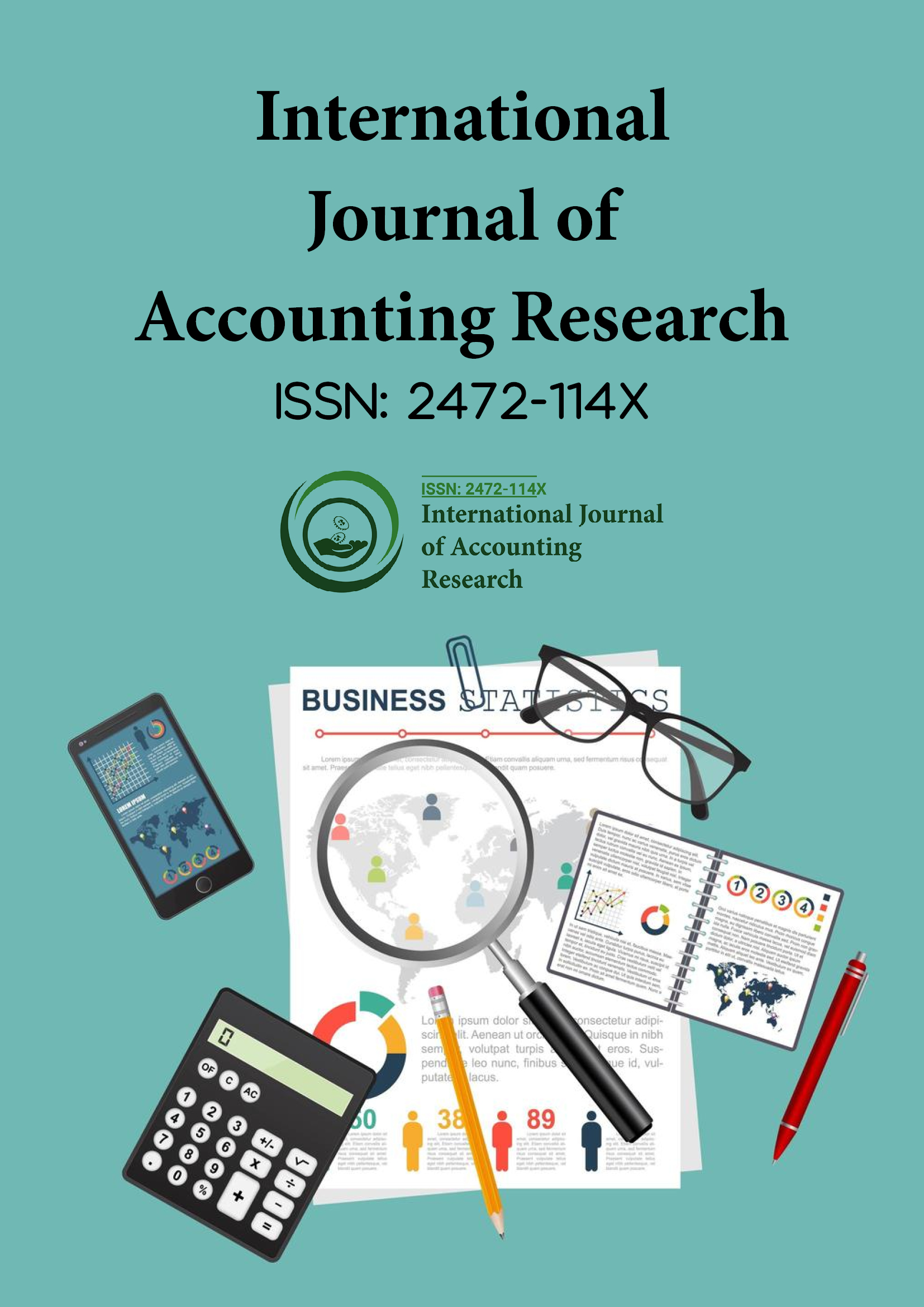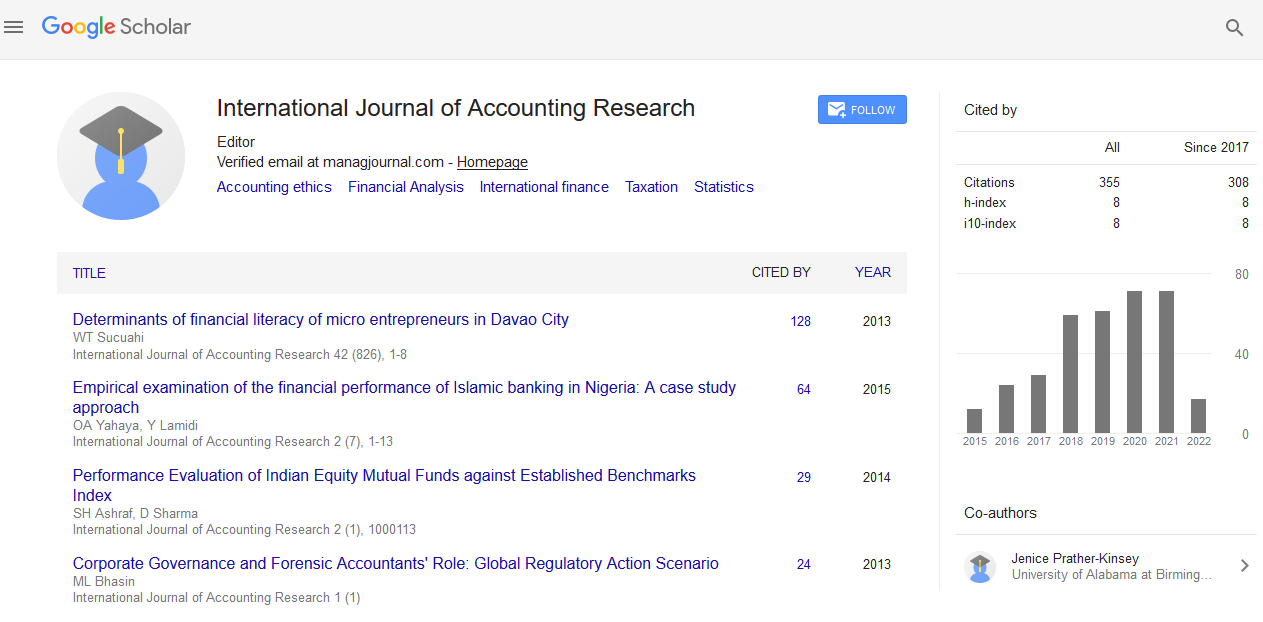Indexed In
- Open J Gate
- RefSeek
- Hamdard University
- EBSCO A-Z
- Scholarsteer
- Publons
- Euro Pub
- Google Scholar
Useful Links
Share This Page
Journal Flyer

Open Access Journals
- Agri and Aquaculture
- Biochemistry
- Bioinformatics & Systems Biology
- Business & Management
- Chemistry
- Clinical Sciences
- Engineering
- Food & Nutrition
- General Science
- Genetics & Molecular Biology
- Immunology & Microbiology
- Medical Sciences
- Neuroscience & Psychology
- Nursing & Health Care
- Pharmaceutical Sciences
Commentary - (2025) Volume 13, Issue 1
Environmental Accounting: Integrating Sustainability into Financial Decision-Making
Keiko Nakamura*Received: 03-Mar-2025, Manuscript No. IJAR-25-29092; Editor assigned: 05-Mar-2025, Pre QC No. IJAR-25-29092 (PQ); Reviewed: 19-Mar-2025, QC No. IJAR-25-29092; Revised: 26-Mar-2025, Manuscript No. IJAR-25-29092 (R); Published: 02-Apr-2025, DOI: 10.35248/2472-114X.25.13.406
Description
As the global economy grapples with the consequences of climate change, resource depletion, and environmental degradation, a new discipline has taken shape within accounting: Environmental accounting. This evolving field seeks to bridge the gap between financial performance and ecological responsibility by systematically incorporating environmental costs and benefits into financial decision-making processes.
Traditionally, companies focused primarily on profit maximization without explicitly accounting for the environmental consequences of their activities. Polluting air or water, overusing natural resources, or generating excessive waste were viewed as externalities costs borne by society rather than by the business. However, increasing regulatory pressures, stakeholder demands for transparency, and long-term risk exposure have forced companies to re-evaluate this approach. Environmental accounting provides a structured way to measure, report, and manage environmental impacts in financial terms.
Environmental accounting can be broadly categorized into two components: Environmental Management Accounting (EMA) and Environmental Financial Accounting (EFA). EMA focuses on internal decision-making, helping companies understand the environmental costs associated with operations, such as waste disposal, energy use, and resource inefficiencies. EFA, on the other hand, deals with external reporting, disclosing environmental liabilities and expenditures in financial statements to inform investors and regulators.
One of the fundamental aspects of environmental accounting is the identification and quantification of hidden environmental costs. Many of these costs such as regulatory compliance, emissions penalties, environmental remediation, or reputational damage are not captured in traditional accounting systems. By making these costs visible, businesses can make more informed decisions about investments, product development, and operational changes. For example, switching to energy-efficient machinery may appear expensive initially but becomes financially justifiable once future carbon tax savings and lower maintenance costs are included in the analysis.
Another critical contribution of environmental accounting is facilitating cost-benefit analyses for sustainability initiatives. Whether evaluating the feasibility of installing solar panels, reducing plastic packaging, or implementing a zero-waste policy, environmental accounting enables companies to assess both the financial and ecological implications. This dual perspective helps align business goals with broader environmental objectives and promotes sustainable value creation.
Environmental accounting also plays an essential role in risk management. Climate change presents both physical risks (e.g., supply chain disruptions due to extreme weather) and transition risks (e.g., policy shifts, changing market preferences). By integrating environmental risk factors into accounting models, companies can better anticipate and mitigate future shocks. Investors, too, benefit from this approach, as it provides a clearer picture of a firm's exposure to environmental liabilities and sustainability performance.
Reporting standards have evolved to support environmental accounting practices. Frameworks such as the Global Reporting Initiative (GRI), the Carbon Disclosure Project (CDP), and the Sustainability Accounting Standards Board (SASB) offer guidelines on how companies should report environmental data. Increasingly, organizations are also aligning their reporting with the recommendations of the Task Force on Climate-related Financial Disclosures (TCFD), which emphasizes climate-related risks and opportunities in financial reporting.
Despite these developments, several challenges hinder the widespread adoption of environmental accounting. One key issue is the difficulty of assigning monetary values to environmental impacts. While it is straightforward to calculate the cost of electricity or waste disposal, valuing biodiversity loss or ecosystem degradation involves complex assumptions and subjective judgments. This lack of standardization can lead to inconsistent reporting and difficulty in comparing companies across sectors and regions.
Citation: Nakamura K (2025). Environmental Accounting: Integrating Sustainability into Financial Decision-Making. Int J Account Res.13:406.
Copyright: © 2025 Nakamura K. This is an open access article distributed under the terms of the Creative Commons Attribution License, which permits unrestricted use, distribution, and reproduction in any medium, provided the original author and source are credited.


